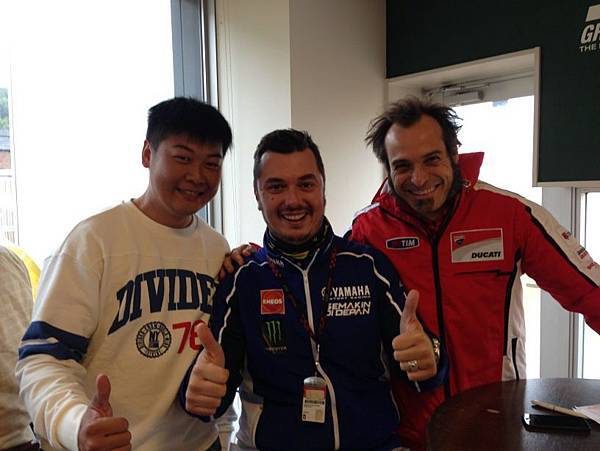MotoGP Tech: 10 Photos
賽道上的機械藝術.
Machine art at the racetrack.
原文 Kevin Cameron 攝影 Kevin Cameron 發佈於 Cycle World
事實上,照片裡這些動人的機械部件不會因為他們所展現出的美麗而有所減損。大自然的真理就是生命會極盡所能的去適應這個世界 - 就像鳥的雙翼和樹枝會在風中舞動。 MotoGP賽車的這些部件透過類似的情形變得美麗,只是他來自於人們的努力而不是數十億年的嘗試和錯誤。
The fact that the subjects of these lovely photos are machine parts does not detract from the beauty they present. Nature is full of the grace of living things adapting to the world around them—a bird’s wings or tree limbs moving and dancing in wind. These elements of MotoGP bikes became beautiful through a similar process but through human intention rather than a billion years of trial and error.

1) Repsol Hondas的人機界面之一。我們來看一下,有一個模式開關(結果顯示在儀表板)和紅色的“RUN”按鈕。以及Brembo的液壓離合器拉桿,在它右上的是某種壓力感知器的連接裝製(force- or line-pressure 請神人解答)連接器。再右邊,一個軟管連接至液壓油的盒子(有人知道他到底叫什麼嗎?),以及在它們之間,拉桿高度調節旋鈕(感覺上應該不是這麼簡單)。握把下方可能是一個姆指煞車。在此背景下,句大的Öhlins 前叉上管。
1) The man-machine interface on one of the Repsol Hondas. We can read, so we see the mode switch (results show up on the dash) and the red “run” button. There’s the Brembo hydraulic clutch lever, and right above their symbol is a connector for the force- or line-pressure sensor. To the right, a hose to the hydraulic reservoir, and between them, a rotary lever-height adjuster. Directly below that might be a thumb brake. In the background, the giant Öhlins upper outer fork tube.

2) 讓我們把坐墊後方的罩子拿掉看看。這些東西看起來是跟車載攝影機有關的設備。遙望前方(請用想像的),看到兩隻被分隔很遠的管子(說的是前叉)-這是因為需要把碟盤外移來接觸更多空氣使它們冷卻的結果。現今當煞車再做動的時候碟盤表面溫度幾乎可以高達攝氏1000度,未來將可以在更多的賽道上使用340mm的碟盤。
2) A view with seatback removed. Some of this stuff looks like it’s associated with the on-board camera equipment. Looking up front, see how very far apart are the two fork tubes—a result of needing room to move brake discs laterally away from the front tire and into faster-moving air for improved brake cooling. Lots of discs reaching surface temps over 1,000 degrees Celsius these days, bringing support for use of bigger 340mm discs at more tracks.

3) 那些Showa下方到底是什麼東西,其實你可以從這些研磨製造品看出一些端倪。請注意因為慣性的關係在煞車時常長會看到後輪離開地面,這時只能靠這些部件來通過彎角。其中一個圓筒形延伸可能是氣壓瓶用來防止壓力油滲漏,另一個裡面可能塞滿了墊片。液壓式的卡鉗有快速拆裝的接頭,也可以看到前輪的速度感應器是七點半方向靠進黃圈的那個東西。
3) Those Showa fork bottoms are the real thing, as you can tell from the tool-path marks from their milled-from-solid manufacturing. Remember that the brake torque that regularly lifts the rear tires of these bikes off the ground on corner approach has to pass through these parts. One of the cylindrical extensions probably contains a gas accumulator whose pressure prevents oil cavitation, and the other contains the valve shim stacks. The hydraulic line to the caliper has a quick-change connector, and you can see a front-wheel speed sensor at 7:30 on the yellow circle.

4) 人們越來越習慣用CNC這個神奇的新工具,在交易完成後只需要"看"他運做就行了。在右邊,你可以看到一個支架(上面有兩個內六角螺絲),連接著懸掛動態感測器(suspension-movement sensor)。左側的旋鈕可以調整車身高度,而SHOWA紅盤上的兩個螺絲頭分別調整“反彈”和“壓縮”,下面失焦的是經過研磨加工的鋁製搖臂連桿。
4) People are so struck by the strangeness and grace of CNC tool-path marks that they have become a “look” in the aftermarket. On the right, you can see the bracket (retained by two 6mm Allen cap screws) that secures the rod for the suspension-movement sensor. The knob on the left is ride height, while the red disc and its two screw heads are for “tension” (rebound) and “compression.” The milled-from-solid aluminum linkage arm disappears downward out of focus.

5) 在技師頭部左側可以看到生長著一大堆賽車的“中樞系統” - ECU(電子控制單元)透過線路接收各種感應器送來的數據送,同時也發送各種指令給各個部件。在圖片的中下方我們看到引擎的“短劍”(Why???) 乾式油底殼。做得深且窄可確保油浸滿管子,所以可以吸到油。引擎外殼透過沙型鑄造(sandcast)經過這樣的熱處理使它有更高的強度。目前正在進行離合器的檢查。
5) To the left of the mechanic’s head you see the growing mass of the racing motorcycle’s “nervous system”—wires rushing sensor data to the ECU and commands flowing away from it. Right at bottom center we see the engine’s “dagger” oil sump, made so deep and narrow to keep the oil pickup always submerged yet allow space for pipes to pass next to it. Engine cases are sandcast because such material can be heat-treated for high strength. A clutch inspection is in progress here.

6) 這是Suter-designed Mahindra Moto3賽車。注意,大型的空氣散熱片在車架的前方。早期引擎的氣箱(airboxes)是由整流罩的兩側透過軟管將空氣倒入 。如今,近氣口在中央,從三角台下面那邊導進去。這樣龐大的攝取量類似於MOTOGP等級的賽車,因為250單缸的允許缸徑跟MOTOGP的最大81mm是相同的。
6) This is the Suter-designed Mahindra Moto3 bike. Note the big air passage through the front of the frame. Early engine airboxes took air by flex-hose from the sides of the fairing front into the airbox through holes in the sides of the frame beams. Today, intakes are central, with the steering stem faired into them. The giant intake is similar to those in MotoGP because this 250’s single cylinder is allowed the same 81mm maximum bore as in MotoGP.

7) Öhlins 用了大型的住設器來調整前叉的油量。前叉的彈力是透過管內的空氣和油的壓縮所形成的。更多的油有會形成更多的“空氣彈力”。在打開的又前叉管上方你可以看到“HRC”字樣。多年來,Honda為了維持必要的排氣管長度找到的空間是把捲區的排氣管藏在坐墊後方。Freddie Spencer 1983年的NS500是第一次採用這個做法。
7) An Öhlins tech uses a large syringe to adjust fork oil quantity. The fork spring(s) are supplemented by the compression of air above the oil in the tube. The more oil there is, the more progressive becomes the “air spring.” Just above the open top of the right fork leg you can make out the letters “HRC.” For years, Honda has found room for necessary exhaust pipe length by curling the tubing up in the seatback. Freddie Spencer’s 1983 NS500 was the first.

8) “我們的發動機”Ducati的滑動式離合器動作並沒有反向扭矩來起動,因此這種起動機直接在曲軸的末端施加魔法。他們也有帶滾輪式發動機。嗯,照片右側直力的外殼看起來相當薄。太彎了,你覺得呢?
8) “We have ignition.” The Ducati’s slipper clutch action does not always have the reverse torque capacity to allow starting on rollers, so this starter spins the crankshaft directly via a hex on the end. The team also carries roller starters. Hmm, that chassis upright on the right side of the photo looks fairly thin. Flex much, you think?

9) 右腳踏板後煞車踏板和後剎車總泵。我能說什麼?多美麗的元件,這麼有吸引力的組合,單一的功能。在左下角,排氣管是由橡膠墊片安裝,然後靠近搖臂提供空間讓他通過。通常後剎車總泵上有很強的作用力,提醒選手要充分的釋放後煞車。
9) Right-hand footpeg and rear brake pedal and master cylinder. What can I say? Beautiful parts, attractive composition, singleness of purpose. At bottom left, an exhaust pipe is supported by rubber mount and link, and the swingarm adjacent is narrowed to provide clearance for its passage. Hefty spring on master cylinder is common, reminding riders to release the rear brake fully.

10) 這是人機界面的另一端。筆記型電腦使我們能讀取和寫入重要的數據:檔位、加速和減速的圖形,傾倒開關(kill switch),電池電壓,每個氣缸的空燃比。在魔法世界,他就是幫助Tolkien(魔戒作者)的英雄們通過危險旅程的關鍵。每個車隊的車庫都會有一個放滿筆電的小房間,工作人員安靜的坐在那邊,評估數據。他們再做什麼呢?他們想知道週日下午會發生什麼事。
10) This is the other pole of the man-machine interface. Laptops allow us to read and write important realities: gear, acceleration, and decel maps, kill switch, battery voltage, the air/fuel ratios for cylinders one through four. Magic words, keys to the kingdom that Tolkien heroes seek through terrible travail and danger. Every factory garage has a back room in which quiet men with laptops sit at a table, evaluating data. What does it all mean? They hope to know by Sunday, noontime.



